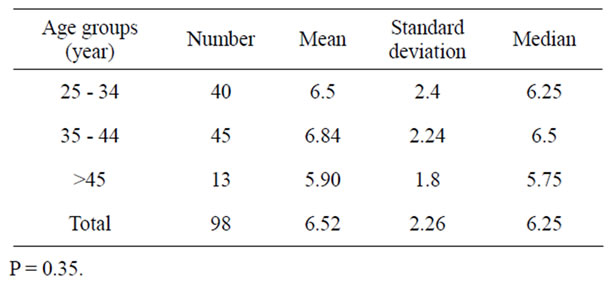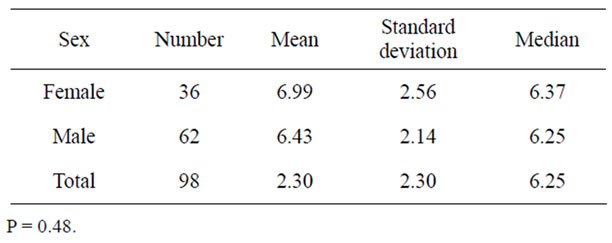Health
Vol. 4 No. 8 (2012) , Article ID: 21995 , 4 pages DOI:10.4236/health.2012.48078
Evaluation of dentists’ awareness about personnel and patients national protection in Yazd dental office
![]()
1Department of Oral and Maxillofacial Radiology, Faculty of Dentistry, Shahid Sadoughi University of Medical Sciences, Yazd, Iran;
*Corresponding Author: ezoddini@gmail.com
2Shahid Sadoughi University of Medical Sciences, Yazd, Iran
Received 18 May 2012; revised 15 June 2012; accepted 28 June 2012
Keywords: Radiation protection; Dental radiography; Knowledge; Dentists
ABSTRACT
Background: Dental radiology had helpful assistant in the diagnosis and treatment of oral diseases. Dentists in their practice have to access benefits of dental oral radiographs against its hazards. They must be aware of new radiation protection techniques and radiation dosage which daily receive. Present study was performed for radiation protection awareness in dentists of Yazd city and their knowledge about recent lowering radiation techniques. Materials & Methods: Present cross sectional study was performed on 102 medical dentists of Yazd city. Our study samples were participated in one Continues Medical Educations (CME) session. Knowledge assessment of study medical dentists was gathered with questionnaire which was given to study participants during CME session. Results: Eighty nine percent of dentists had poor and 11% had moderate awareness about radiation protection techniques. There was no significant difference between mean of knowledge scores among study participants according their age groups, job experiences and genders. Conclusion: The knowledge of dentists about radiation protection techniques was very poor and they should implement recent and appropriate radiation protection techniques and guidelines.
1. INTRODUCTION
Dental radiology is one of the useful filed in the diagnosis and treatment of periodontal diseases, pathologies and other oral diseases [1]. Dentist in their practice have to access benefits of dental oral radiographs against its hazards. Although dentists expose with lower radiation in comparison with other health care providers, noted exposure must be minimized for better safety [2,3].
Some complications such as skin erythema, cataract and fibrosis and unusual fetal growth were reported as decisive impacts of radiation exposure in higher than safe dosage. Although dentist always did not expose with noted dosage in dental diagnostic studies, we had not evidences which were reported that radiological studies had no dangerous impact and completely safe. Diagnostic radiation as weekly carcinogen might be accommodating in radiological studies of many of patients during several years [4].
Practical judgment has to use by dentists in prescribing radiological studies for their patients and their diagnosis must begin with history and physical examination. Dentist must aware from new radiation protection techniques and radiation dosage which daily receive. Present study was performed for radiation protection awareness in dentists of Yazd city and assessment of their knowledge about techniques of lowering radiation exposure to their patients and office employers.
2. MATERIAL AND METHODS
Present cross sectional study was performed on 102 medical dentists of Yazd city. Our study samples were participated in one Continues Medical Educations (CME) session. Present study was confirmed in ethical research committee of Yazd University of medical sciences and health services. Knowledge assessment of study medical dentists were gathered with questionnaire which were prepared according National Council on Radiation Protection & Measurements (NCRP) standards and give to study participants during CME session. After oral session for description of study questionnaire we give questionnaire to the dentists. Uncompleted questionnaires were excluded from the study. Knowledge scores in the present study were classified into the three groups: week (0 - 10), moderate (10 - 15) and high (15 - 20). Importance of CME for improving knowledge scores of dentist were divided to low, moderate, high and very high groups.
Statistical Analysis
Data of the study were collected and entered to the computer in SPSS software. For assessment of impact of study variables on knowledge level of participated dentists, their age was classified into the three age groups: 25 - 34, 35 - 44 and older than 45 years old. Job experiences in our dentists were classified into the three groups: less than five years, 5 - 9 years, 10 - 14 years and higher than 15 years. Mean of knowledge scores between study variables were analyzed by analysis of variance (ANOVA) tests and all calculated P-values less than 0.05 were assumed as significant results.
3. RESULTS
In the present study, 102 dentists were participated and knowledge level was assessed during one of CME session at Yazd city. Between study participants, dentists of 35 - 44 years old had highest and dentist of older than 45 years old had lowest mean of knowledge scores. There was no significant difference between mean of knowledge scores among three age groups of our patients (P = 0.35) (Table 1).
Dentist with 10 - 14 job experiences had highest and dentist with 1 - 4 job experiences had lowest mean of knowledge scores. There was no significant difference between mean of knowledge scores among four job experiences of study dentists (P = 0.24) (Table 2).
Female dentists had higher knowledge score in compare with male dentists, but this difference was not significant (6.99 vs 6.43; P = 0.48) (Table 3).
Dentist had higher knowledge scores about preventive techniques for their patients in compare with themselves and personnel’s of radiology clinics (6.7 vs 6.5; P = 0.33) (Table 4).
4. DISCUSSION
Radiological study is inevitable for medical dentists and had to perform with suitable radiation prevention techniques. Technical improvement was happened in radiological methods and radiation time was decreased from nine seconds at 1920 to two seconds at present time.

Table 1. knowledge level of study participants according their age groups.

Table 2. knowledge level of study participants according their job experiences.

Table 3. knowledge level of study participants according their gender.

Table 4. knowledge level of study participants according their protection filed.
Radiological study must be performed in some situation that its findings had higher importance than its disadvantages and these comments had been known as ALARA (As Low As Reasonably Achievable) [1].
Knowledge level of study dentist was weak. Mutyabule T. K. and Whaites J. in their study had been reported similar results with present study and stressed on renewed CME programs about radiation protective techniques improvement and upgrade of radiation protective devices [5]. Geist et al. reported that knowledge scores in dentists with higher than 15 job experiences had significantly higher than other dentist with lower job experiences [6].
Shahab S. et al., [7] concluded that the majority of dentists in the study group did not select the proper method, material and equipment in order to minimize the exposure of their patient to unnecessary radiation in dental radiograph.
American Dentists Association (ADA) and ALARA had recommended that lid apron and necklace are necessary for minimizing irrelevant radiation [1]. Digital radiography had low usage in office of study dentist due to their weak knowledge about this device. Update information related to usage of digital radiography might increase tendency of dentists and patients this to this suitable radiological device [8]. Goudarzipour and Ebrahimi Moghadam et al. reported same results in office of dentists in Yazd city and showed that patients and dentists less use film keeper due to its hardship usage [8].
Knowledge of dentist in our study was not enough about maximum annual allowed radiation dosage. Some of dentist think that they did not need to maximum of allowed radiation dosage and this believe might be responsible for lower knowledge about that among dentists. Tavakoli et al. in their study had similar findings and rate of radiography films in dental office was 0% at 1997 and 10% at 2004 [9]. Goudarzi pour and Ebrahimi Moghadam reported that only 23% of dental offices and 70% of clinics were assessed by national atomic energy association for radiation leakage [8].
Dentist knowledge about personal and patients’ radiation protection were weak and was similar with Shahab et al. study [7]. All of study dentists beloved that they need to receive new CME programs in this field and our findings were similar with findings of Tavakoli et al. study at Shahid Beheshti University of medical science [9]. Davies et al. reported that 51% of dentists believed that their educations about radiation protection were not enough [10]. Dentist must have suitable knowledge about radiation protection in their offices and updated pandects and information for new protective devices [8]. Many of preventive strategies were not performed in dental clinics of centers in educational universities and radiation protection doctrine must be reviewed [8].
Tok Mutyaule and his college us reported that devices which dentists in Uganda used for radiation protection were not matched with new European recommendation [5]. This study as the same as with present study had stressed on designing new and modern radiation protection guidelines. Rout J. reported that Legislation requires that users of radiation, including dentists and members of the dental team, understand the basic principles of radiation physics, hazards and protection, and are able to undertake dental radiography safely with the production of high quality, diagnostic images [11]. Designing and performing regular CME programs for improving knowledge of dentists about newest radiological and diagnostic techniques are importance and recommended for medical dentists.
The present study had some limitations. First, we assessed knowledge level in one of CME session and our results are under impact of selection bias. Second, we assessed only dentist of one city, it is better that we assessed dentists of several cities with different idea. Third, our sample size was low for rollout of associations and power of our study was not in acceptance range for analysis.
![]()
![]()
REFERENCES
- American Dental Association Council on Scientific Affairs (2006) The use of dental radiographs: Update and recommendations. The Journal of the American Dental Association, 137, 1304-1312. http://www.ncbi.nlm.nih.gov/pubmed/16946440
- Freeman, J.P. and Brand, J.W. (1994) Radiation doses of commonly used dental radiographic surveys. Oral Surgery, Oral Medicine, Oral Pathology, 77, 285-289. doi:10.1016/0030-4220(94)90301-8
- Gibbs, S.J., Pujol, A. Jr., Chen, T.S. and James, A. Jr. (1988) Patient risk from intraoral dental radiography. Dentomaxillofacial Radiology, 17, 15-23.
- Takano, Y., Okazaki, K., Ono, K. and Kai, M. (2005) Experimental and theoretical studies on radiation protective effect of a lighter non-lead protective apron. Nippon Hoshasen Gijutsu Gakkai Zasshi, 61, 1027-1032.
- Mutyabule, T.K. and Whaites, E.J. (2002) Survey of radiography and radiation protection in general dental practice in Uganda. Dentomaxillofacial Radiology, 31, 164- 169. doi:10.1038/sj.dmfr.4600685
- Geist, J.R. and Katz, J.O. (2002) The use of radiation dose-reduction techniques in the practices of dental faculty members. Journal of Dental Education, 66, 697-702.
- Shahab, S., Kavosi, A., Nazarinia, H., Mehralizadeh, S., Mohammadpour, M. and Emami, M. (2012) Compliance of Iranian dentists with safety standards of oral radiology. Dentomaxillofacial Radiology, 41, 159-164. doi:10.1259/dmfr/29207955
- Goudarzipou, D. and Ebrahimoghadam, S. (2005) Evaluation of X-ray protection measurements in intraoral radiography equipped center in Yazd city. Journal of Density, 17, 61-68.
- Amin Tavakli, M., Nikneshan, S. and Varshosaz, M. (2004) Protection against X-ray in dental clinics of Shahid Beheshti University of Medical Sciences in 1381. Beheshti University Dental Journal, 22, 197-202.
- Davies, C., Grange, S. and Trevor, M.M. (2005) Radiation protection practices and related continuing professional education in dental radiography: A survey of practitioners in the North-east of England. Radiography, 11, 255-261. doi:10.1016/j.radi.2005.07.009
- Rout, J. and Brown, J. (2012) Ionizing radiation regulations and the dental practitioner: 1. The nature of ionizing radiation and its use in dentistry. Dental Update, 39, 191- 192, 195-198, 201-203.

